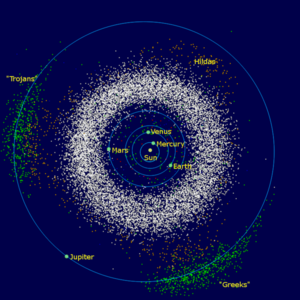
Back عائلة هيلدا Arabic Grup de Hilda Catalan Hildina skupina Czech Hilda-Gruppe German Hilda grupo Esperanto Grupo de Hilda Spanish خانواده هیلدا Persian Hilda-ryhmä Finnish Groupe de Hilda French Հիլդայի ընտանիք Armenian

| Jupiter trojans Orbits of planets Sun | Hilda group Asteroid belt Near-Earth objects (selection) |
The Hilda asteroids (adj. Hildian) are a dynamical group of more than 6,000 asteroids located beyond the asteroid belt but within Jupiter's orbit, in a 3:2 orbital resonance with Jupiter.[1][2] The namesake is the asteroid 153 Hilda.
Hildas move in their elliptical orbits in such a fashion that they arrive closest to Jupiter's orbit (i.e. at their aphelion) just when either one of Jupiter's L5, L4 or L3 Lagrange points arrives there.[3] On their next orbit their aphelion will synchronize with the next Lagrange point in the L5–L4–L3 sequence. Since L5, L4 and L3 are 120° apart, by the time a Hilda completes an orbit, Jupiter will have completed 360° − 120° or two-thirds of its own orbit. A Hilda's orbit has a semi-major axis between 3.7 and 4.2 AU (the average over a long time span is 3.97), an eccentricity less than 0.3, and an inclination less than 20°.[4] Two collisional families exist within the Hilda group: the Hilda family and the Schubart family. The namesake for the latter family is 1911 Schubart.[5]
The surface colors of Hildas often correspond to the low-albedo D-type and P-type; however, a small portion are C-type. D-type and P-type asteroids have surface colors, and thus also surface mineralogies, similar to those of cometary nuclei. This implies that they share a common origin.[4][6]
- ^ Cite error: The named reference
MPC-hilda-listwas invoked but never defined (see the help page). - ^ Cite error: The named reference
Broz-2008was invoked but never defined (see the help page). - ^ Matthias Busch. "The triangle formed by the Hilda asteroids". EasySky. Retrieved 2009-12-15.
- ^ a b Ohtsuka, Katsuhito; Yoshikawa, M.; Asher, D. J.; Arakida, H.; Arakida, H. (October 2008). "Quasi-Hilda comet 147P/Kushida-Muramatsu. Another long temporary satellite capture by Jupiter". Astronomy and Astrophysics. 489 (3): 1355–1362. arXiv:0808.2277. Bibcode:2008A&A...489.1355O. doi:10.1051/0004-6361:200810321. S2CID 14201751.
- ^ Brož, M.; Vokrouhlický, D. (2008). "Asteroid families in the first-order resonances with Jupiter". Monthly Notices of the Royal Astronomical Society. 390 (2): 715–732. arXiv:1104.4004. Bibcode:2008MNRAS.390..715B. doi:10.1111/j.1365-2966.2008.13764.x. S2CID 53965791.
- ^ Gil-Hutton, R.; Brunini, Adrián (2008). "Surface composition of Hilda asteroids from the analysis of the Sloan Digital Sky Survey colors". Icarus. 193 (2): 567–571. Bibcode:2008Icar..193..567G. doi:10.1016/j.icarus.2007.08.026. Retrieved 14 April 2014.